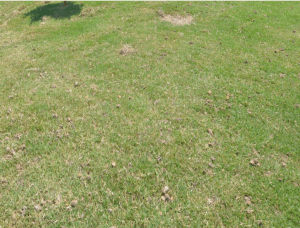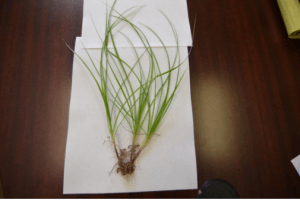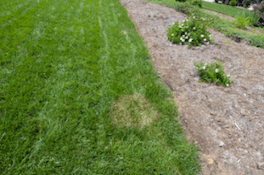Proper Mowing Height Proper mowing height is essential to proper turf health and performance. Fescue requires a mowing height of 3.5″ to 4.0″. Research has proven that maintaining a mowing height of 3.5″ – 4” on fescue drastically reduces the amount of crabgrass in the lawn. Mowing at this height will also help promote healthy… Read more »
Proper mowing height is essential to proper turf health and performance. Fescue requires a mowing height of 3.5″ to 4.0″. Research has proven that maintaining a mowing height of 3.5″ – 4” on fescue drastically reduces the amount of crabgrass in the lawn. Mowing at this height will also help promote healthy turf and hold back broadleaf weeds.
Bermuda requires a mowing height between 0.5″ to 1.5″ at the highest. Bermuda is a high maintenance vegetative turf requiring low and frequent mowing. Bermuda will thin and not thicken properly if allowed to grow above 1.5″. Bermuda will have a brown leafless appearance after cutting if turf is not cut every three to four days during peak growing season. Try to cut Bermuda at 2.0″ for the last cutting of the season before turf goes dormant.
Zoysia performs best between .75″ to 2.5″ at the highest depending on the variety. Zoysia should be cut every four to five days for best result. Centipede should be cut around 0.5″ to 1.5″. Centipede is a slow growing turf and should be cut when it reaches the proper mowing height. St. Augustine performs best 1.0″ to 2.5″. St. Augustine should be cut every four to five days when needed.
This link contains valuable information about proper mowing height having the ability to offer excellent crabgrass and miscellaneous broadleaf weed control.
http://www.turffiles.ncsu.edu/alerts/grasses/mowing-height-impacts-weed-populations

Plugs pulled from Bermuda lawn
Core aeration removes a small plug of thatch and soil and should be completed annually on Warm Season Turf (Bermuda, Zoysia and Centipede). Core aeration is significantly important if your lawn received winter injury this year. It should be completed annually from June to August.
Core aeration will:

Bermuda in Fescue
There is a weed management program for suppressing and controlling Bermuda in Fescue. This program starts in June and ends in late August to September. A combination of products is applied every 30 days during this time period to suppress Bermuda from spreading and will slowly eliminate Bermuda growth. It will generally take a couple years to see results of this suppression program.
This program will not help lawns with well-established Bermuda covering large areas. The Bermuda Suppression program is for lawns with scattered pockets of Bermuda with a fair stand of Fescue in those areas. Lawn renovation will be needed, starting in late July, if Bermuda covers large sections of the lawn.
 Yellow Nutsedge is a prolific and very difficult to control weed in many lawns and natural areas. Nutsedge is not a broadleaf weed or grassy weed but is in the sedge family. Yellow Nutsedge is a summer perennial that flourishes from April/May to around September/October. It reproduces from tubers (nutlets) under the soil and can spread from rhizomes. Each plant can produce hundreds of tubers during its growing season. These new tubers will be new plants in the years to come. Nutsedge will have a triangle stem and is easily felt when you twirl a stem between your thumb and forefinger. Yellow Nutsedge will grow much faster than the existing turf and will have a thin shiny appearance.
Yellow Nutsedge is a prolific and very difficult to control weed in many lawns and natural areas. Nutsedge is not a broadleaf weed or grassy weed but is in the sedge family. Yellow Nutsedge is a summer perennial that flourishes from April/May to around September/October. It reproduces from tubers (nutlets) under the soil and can spread from rhizomes. Each plant can produce hundreds of tubers during its growing season. These new tubers will be new plants in the years to come. Nutsedge will have a triangle stem and is easily felt when you twirl a stem between your thumb and forefinger. Yellow Nutsedge will grow much faster than the existing turf and will have a thin shiny appearance.
Post-emergent broadleaf weed controls for weeds like clover and dandelions will not control Nutsedge. There are limited products available for controlling Nutsedge and all of them require frequent applications over multiple years to offer acceptable control.
 Fairway Green and other lawn care companies are starting to see a trend with some Zoysia lawns, along with some other warm season turf, receiving regular winter injury and slow green up. Many of these lawns appear to be growing in less than ideal conditions. This could be north facing locations, light to moderate shade, poor quality soil, water standing or moving through sections of the lawn and heavy traffic especially while dormant or transitioning. Turf growing in these conditions; do not have an opportunity to make a full recovery in the summer due to our short growing season. This pattern continues from year to year until large sections of the lawn do not recover. Warm season turf generally does not completely break full dormancy and start growing till the end of May or early June. Some Zoysia turf varieties will start activity sooner than others. Most warm season turf will start to transition into dormancy around mid-September and start to come out of dormancy around mid-April or early May. Active growth and recovery usually do not start till the last week of May into early June. In essence, warm season turf grasses are actively growing and recovering June, July, August and part of September. They may appear to be green and growing out of this window but are more or less just in transition.
Fairway Green and other lawn care companies are starting to see a trend with some Zoysia lawns, along with some other warm season turf, receiving regular winter injury and slow green up. Many of these lawns appear to be growing in less than ideal conditions. This could be north facing locations, light to moderate shade, poor quality soil, water standing or moving through sections of the lawn and heavy traffic especially while dormant or transitioning. Turf growing in these conditions; do not have an opportunity to make a full recovery in the summer due to our short growing season. This pattern continues from year to year until large sections of the lawn do not recover. Warm season turf generally does not completely break full dormancy and start growing till the end of May or early June. Some Zoysia turf varieties will start activity sooner than others. Most warm season turf will start to transition into dormancy around mid-September and start to come out of dormancy around mid-April or early May. Active growth and recovery usually do not start till the last week of May into early June. In essence, warm season turf grasses are actively growing and recovering June, July, August and part of September. They may appear to be green and growing out of this window but are more or less just in transition.
It is not uncommon to see areas in a Zoysia lawn slow to green up and may take to the middle part of June.

Brown Patch Fungus developing
Summer is turf disease season for cool season grasses. Brown patch fungus started in early May this year. It is always better to control diseases preventively vs. curatively.
Brown Patch Fungus activates within a distinct set of climatic parameters. Brown Patch will activate when the temperatures are above 75 degrees with high atmospheric moisture. This moisture can be in the form of rainfall, irrigation or humidity.
Signs of Brown Patch will be an off color similar to drought stress, lesions on the leaf blade, browning of the turf in circles or areas. The easiest way to identify Brown Patch is to stand away from the lawn and look for a shadow appearance on the lawn. Once you identify the area of concern, look at the leaf blades of the plant for tan or brown lesions. If you see these lesions more than likely you have Brown Patch. Drought stress can be mistaken for Brown Patch. Drought stress will make the leaves fold at the center giving the leaf blade a straw appearance.
Unfortunately, fescue has little or no resistance to Brown Patch Fungus. Several seed companies are currently trying to increase their turf type fescue varieties to have resistance to Brown Patch Fungus. However, breeding programs take years to develop successful new varieties of turf type fescue.
There are a couple things you can do to help reduce Brown Patch activity. Avoid watering past 2:30 pm. This will give the plant time to dry before nightfall. Cut lawn on a regular basis and at the proper height for your type of turf. This will allow more air circulation across the leaf blade.
A fungicide can be applied that will arrest the fungus for approximately 25 to 28 days. If the fungicide is applied before damage is done to the leaf blade or plant, the fungicide will give the plant time to recover. Due to the high humidity level in this part of the country, Brown Patch can go active again after the fungicide has expired in about 25 days. Another application will be necessary to prevent damage to the plant from Brown Patch Fungus. Many people are utilizing our Preventative Fungicide Program to prevent major damage to their turf.
Japanese beetles will be making their appearance this month. Japanese Beetles enjoy eating the leaves of many ornamental trees, shrubs and garden plants. Many have firsthand experience with the damage beetles can create to the desired plants. Roses, Crepe Myrtles and Cherry trees are some of the first in our area to see Japanese damage.
For additional information visit: http://www.turffiles.ncsu.edu/insects/japanese-beetle
Safely Enjoy the Outdoors this Summer by Controlling Disease-Ridden Mosquitos At Home. We all know Mosquito transmit diseases like West Nile Virus, Encephalitis and Chikungumya. Now we have another one to worry about; Zika! Fairway Green’s Mosquito Control program can help control Mosquitos giving you and your family peace of mind. Receive $10.00 of your first application. *New customers only, cannot be combined w/other offers.
